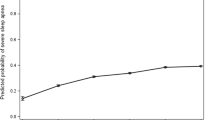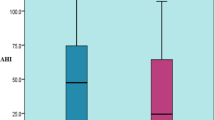Abstract
The Chinese population has a comparable prevalence of obstructive sleep apnea (OSA) compared to their Caucasian counterparts, but are notably less obese. Given this difference in body weight, Chinese patients could have a distinct OSA phenotype. We aimed to compare the characteristics of obstructive events in Chinese and Caucasian individuals matched for OSA severity. Chinese and Caucasian subjects with moderate-to-severe OSA (apnea–hypopnea index (AHI) ≥ 20events/h) were included in the study (n = 90) and matched for age, gender and AHI. Data were analysed to identify differences in event type, effect of sleep state and body position, degree of hypoxemia, and prevalence of metabolic risk factors. Data presented are Mean ± SEM or Median (IQR). Chinese subjects had a significantly lower body mass index (BMI) compared to AHI-matched Caucasian counterparts [27 (25–30) versus 34 (30–39) kg/m2, p < 0.001]. Chinese subjects had more apneas compared to Caucasian subjects [14.4 (5.8–31.8) versus 8.1 (2.2–20.7) events/h, p = 0.011]. Events were longer in the Chinese group (apnea: 25.1 ± 1.2 s versus 19.3 ± 1.3 s, p = 0.001; hypopnea 25.3 ± 1.0 s versus 22.9 ± 1.0 s, p = 0.03), but were associated with less hypoxemia (% time < 90%: 14.6 ± 2.5 versus 25.0 ± 3.7%, p = 0.01). Chinese individuals with moderate-to-severe OSA have a distinct phenotype characterised by longer and more frequent apneas, yet less hypoxemia, in the setting of a lower BMI, compared to Caucasians of equivalent disease severity. Postulated mechanisms include differing upper airway anatomy, control of breathing or lung reserve.




Similar content being viewed by others
References
Ong CW, O’Driscoll DM, Truby H, et al. The reciprocal interaction between obesity and obstructive sleep apnoea. Sleep Med Rev. 2013;17(2):123–31.
Peppard PE, Young T, Palta M, et al. Longitudinal study of moderate weight change and sleep-disordered breathing. JAMA. 2000;284(23):3015–21.
Newman AB, Foster G, Givelber R, et al. Progression and regression of sleep-disordered breathing with changes in weight: the Sleep Heart Health Study. Arch Intern Med. 2005;165(20):2408–13.
Frey WC, Pilcher J. Obstructive sleep-related breathing disorders in patients evaluated for bariatric surgery. Obes Surg. 2003;13(5):676–83.
Ip MS, Lam B, Tang LC, et al. A community study of sleep-disordered breathing in middle-aged Chinese women in Hong Kong: prevalence and gender differences. Chest. 2004;125(1):127–34.
Bixler EO, Vgontzas AN, Lin HM, et al. Prevalence of sleep-disordered breathing in women: effects of gender. Am J Respir Crit Care Med. 2001;163(3 Pt 1):608–13.
Young T, Palta M, Dempsey J, et al. The occurrence of sleep-disordered breathing among middle-aged adults. N Engl J Med. 1993;328(17):1230–5.
Ip MS, Lam B, Lauder IJ, et al. A community study of sleep-disordered breathing in middle-aged Chinese men in Hong Kong. Chest. 2001;119(1):62–9.
World Health Organisation. Global status report on noncommunicable diseases. Geneva: World Health Organisation; 2014.
Lam B, Lam DC, Ip MS. Obstructive sleep apnoea in Asia. Int J Tuberc Lung Dis. 2007;11(1):2–11.
Ong KC, Clerk AA. Comparison of the severity of sleep-disordered breathing in Asian and Caucasian patients seen at a sleep disorders center. Respir Med. 1998;92(6):843–8.
Li KK, Kushida C, Powell NB, et al. Obstructive sleep apnea syndrome: a comparison between Far-East Asian and white men. Laryngoscope. 2000;110(10 Pt 1):1689–93.
Series F, Cormier Y, Forge JL. Influence of apnea type and sleep stage on nocturnal postapneic desaturation. Am Rev Respir Dis. 1990;141(6):1522–6.
Oksenberg A, Arons E, Nasser K, et al. REM-related obstructive sleep apnea: the effect of body position. J Clin Sleep Med. 2010;6(4):343–8.
Joosten SA, O’Driscoll DM, Berger PJ, et al. Supine position related obstructive sleep apnea in adults: pathogenesis and treatment. Sleep Med Rev. 2014;18(1):7–17.
Iber C, Ancoli-Israel S, Chesson A, et al. The AASM manual for the scoring of sleep and associated events: rules, terminology and technical specifications. 1st ed. Westchester: American Academy of Sleep Medicine; 2007.
Lam JC, Lam B, Lam CL, et al. Obstructive sleep apnea and the metabolic syndrome in community-based Chinese adults in Hong Kong. Respir Med. 2006;100(6):980–7.
Lam B, Ip MS, Tench E, et al. Craniofacial profile in Asian and white subjects with obstructive sleep apnoea. Thorax. 2005;60(6):504–10.
Punjabi NM, Ahmed MM, Polotsky VY, et al. Sleep-disordered breathing, glucose intolerance, and insulin resistance. Respir Physiol Neurobiol. 2003;136(2–3):167–78.
O’Neill S, O’Driscoll L. Metabolic syndrome: a closer look at the growing epidemic and its associated pathologies. Obes Rev. 2015;16(1):1–12.
Grundy SM. Obesity, metabolic syndrome, and cardiovascular disease. J Clin Endocrinol Metab. 2004;89(6):2595–600.
Gleeson K, Zwillich CW, White DP. The influence of increasing ventilatory effort on arousal from sleep. Am Rev Respir Dis. 1990;142(2):295–300.
Vold ML, Aasebo U, Hjalmarsen A, et al. Predictors of oxygen saturation </=95% in a cross-sectional population based survey. Respir Med. 2012;106(11):1551–8.
Liu Y, Lowe AA, Zeng X, et al. Cephalometric comparisons between Chinese and Caucasian patients with obstructive sleep apnea. Am J Orthod Dentofacial Orthop. 2000;117(4):479–85.
Lee RW, Vasudavan S, Hui DS, et al. Differences in craniofacial structures and obesity in Caucasian and Chinese patients with obstructive sleep apnea. Sleep. 2010;33(8):1075–80.
Ingman T, Nieminen T, Hurmerinta K. Cephalometric comparison of pharyngeal changes in subjects with upper airway resistance syndrome or obstructive sleep apnoea in upright and supine positions. Eur J Orthod. 2004;26(3):321–6.
Villaneuva AT, Buchanan PR, Yee BJ, et al. Ethnicity and obstructive sleep apnoea. Sleep Med Rev. 2005;9(6):419–36.
Li Z, Du L, Li Y, et al. Characterization of primary symptoms leading to Chinese patients presenting at hospital with suspected obstructive sleep apnea. J Thorac Dis. 2014;6(5):444–51.
Yuan X, Fang J, Wang L, et al. Adequate continuous positive airway pressure therapy reduces mortality in Chinese patients with obstructive sleep apnea. Sleep Breath. 2015;19(3):911–20.
Author information
Authors and Affiliations
Corresponding author
Ethics declarations
Conflict of interest
All authors declare that they have no conflict of interest.
Ethical approval
Ethical approval for this study was granted by the Eastern Health Human Research Ethics Committee. For this type of study formal consent is not required.
Rights and permissions
About this article
Cite this article
Pham, J., Young, A., Kuo, Y.T. et al. Polysomnographic comparison between Chinese and Caucasian patients with obstructive sleep apnea. Sleep Biol. Rhythms 16, 223–230 (2018). https://doi.org/10.1007/s41105-018-0144-z
Received:
Accepted:
Published:
Issue Date:
DOI: https://doi.org/10.1007/s41105-018-0144-z




